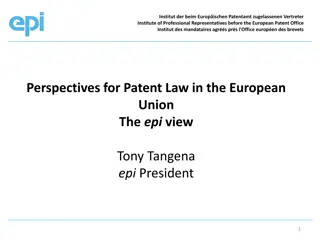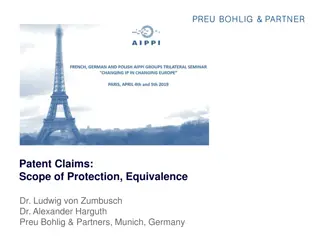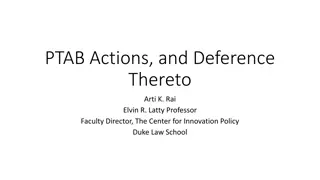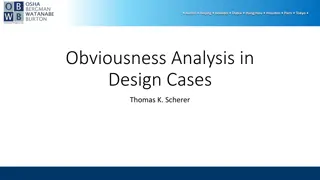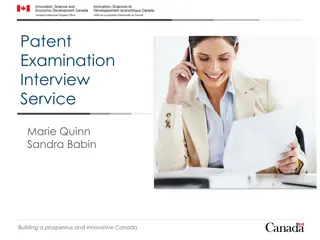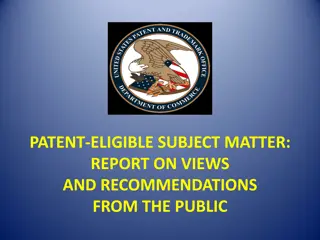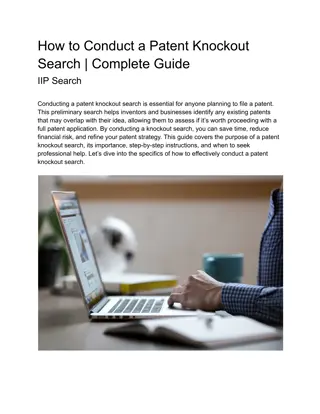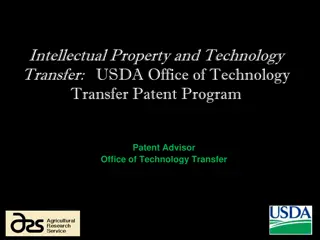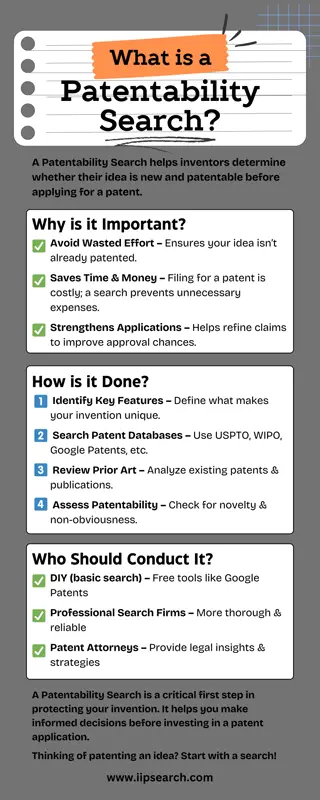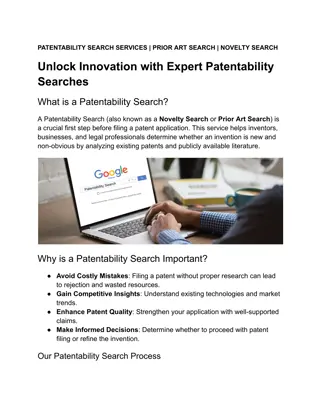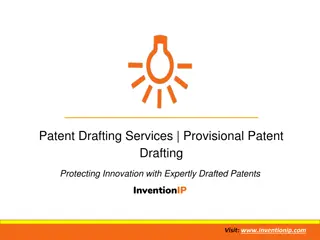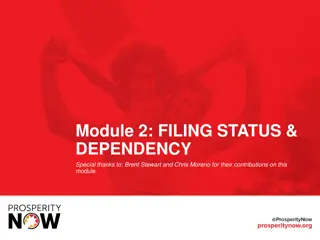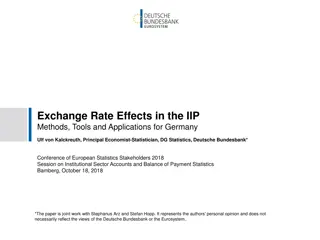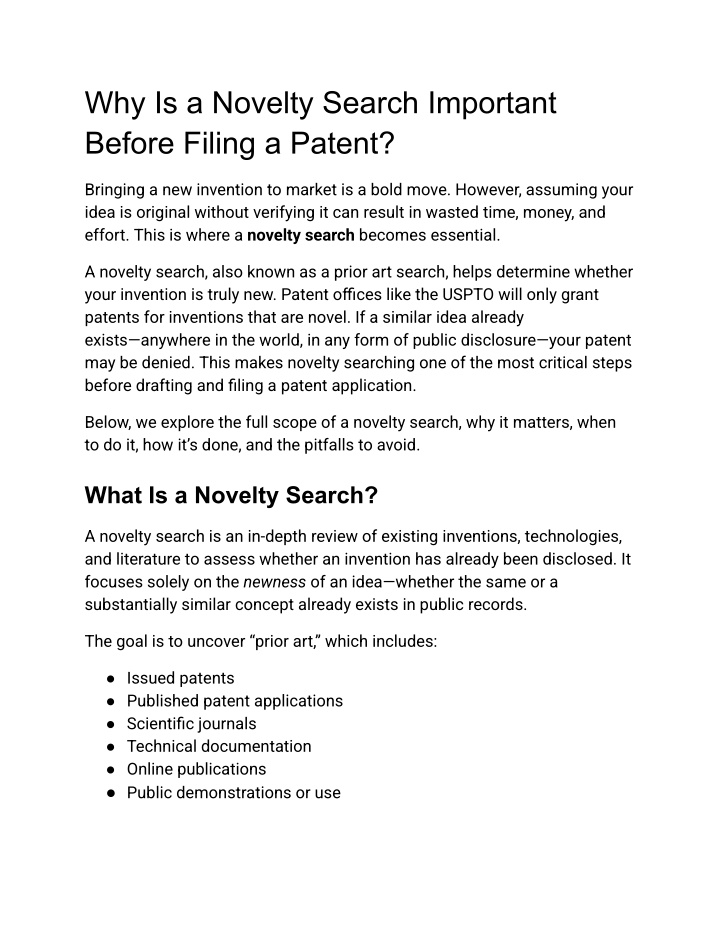
Why a Novelty Search Is Crucial Before Filing a Patent | IIP Search
A novelty search is a vital step before filing a patent, helping inventors avoid costly rejections and wasted resources. Why identifying prior art early can strengthen your patent application, improve claim quality, and guide better business decision
Download Presentation

Please find below an Image/Link to download the presentation.
The content on the website is provided AS IS for your information and personal use only. It may not be sold, licensed, or shared on other websites without obtaining consent from the author. If you encounter any issues during the download, it is possible that the publisher has removed the file from their server.
You are allowed to download the files provided on this website for personal or commercial use, subject to the condition that they are used lawfully. All files are the property of their respective owners.
The content on the website is provided AS IS for your information and personal use only. It may not be sold, licensed, or shared on other websites without obtaining consent from the author.
E N D
Presentation Transcript
Why Is a Novelty Search Important Before Filing a Patent? Bringing a new invention to market is a bold move. However, assuming your idea is original without verifying it can result in wasted time, money, and effort. This is where a novelty search becomes essential. A novelty search, also known as a prior art search, helps determine whether your invention is truly new. Patent offices like the USPTO will only grant patents for inventions that are novel. If a similar idea already exists anywhere in the world, in any form of public disclosure your patent may be denied. This makes novelty searching one of the most critical steps before drafting and filing a patent application. Below, we explore the full scope of a novelty search, why it matters, when to do it, how it s done, and the pitfalls to avoid. What Is a Novelty Search? A novelty search is an in-depth review of existing inventions, technologies, and literature to assess whether an invention has already been disclosed. It focuses solely on the newness of an idea whether the same or a substantially similar concept already exists in public records. The goal is to uncover prior art, which includes: Issued patents Published patent applications Scientific journals Technical documentation Online publications Public demonstrations or use
Unlike broader patentability or freedom-to-operate (FTO) searches, a novelty search does not analyze commercial risks or legal ownership. Its sole purpose is to check if someone has already thought of your idea and disclosed it publicly. Definition and Scope A novelty search scans for documents that disclose any element of your invention that could block a future patent. It must be global in scope, since prior art can come from any country or language. Patent offices consider disclosures from anywhere in the world when evaluating novelty. This type of search is most effective when it focuses tightly on the invention s unique features claims, functionality, configuration, or mechanism not general ideas or industries. Difference from Patentability and FTO Searches While related, these searches serve different purposes: Novelty search: Confirms if the invention is new. Patentability search: Includes novelty but also examines usefulness and non-obviousness. Freedom-to-operate search: Checks if commercializing the invention could infringe existing patents. If you're at the idea or prototyping stage, a novelty search is the appropriate first step. Key Reasons to Conduct a Novelty Search Skipping a novelty search can lead to denied patent applications, financial losses, or missed competitive opportunities. Here s why it should be non-negotiable: Avoiding Wasted Time and Money
Filing a patent can cost between $5,000 and $20,000 when including attorney fees, government filing fees, and technical drawings. Without a novelty search, you risk pouring these resources into an application that will be rejected outright. Example: An inventor once spent $8,000 filing a utility patent, only to discover that a nearly identical invention had been published in a Korean journal years earlier. A basic novelty search would have flagged this before any money was spent. Identifying Similar Inventions Many inventions aren't 100% unique but rather improvements or combinations of existing ideas. A novelty search shows what s already out there helping you determine how to make your concept truly distinct. You may discover: Existing patents with overlapping claims Products or prototypes solving similar problems Areas where innovation is still possible Knowing the competitive landscape improves both your invention and its protectability. Improving Patent Draft Quality Once you identify similar inventions, you can refine your own claims to emphasize novelty. A well-informed patent application can better withstand USPTO scrutiny and future litigation. Attorneys can: Draft around existing prior art Use specific terminology to show differences Strengthen technical descriptions with supporting arguments
This leads to a more robust and enforceable patent. Strategic Business Decisions If the novelty search reveals that your invention is already patented or widely disclosed, it may influence your decision to: Abandon or pivot the idea Enter licensing negotiations Focus R&D on alternative designs This prevents late-stage surprises and aligns innovation with business goals When Should You Perform a Novelty Search? Ideally, conduct a novelty search: Before preparing a provisional patent application Before disclosing the idea publicly Before approaching investors or partners Before spending heavily on R&D Performing the search early allows you to adjust your design or pivot to more promising ideas. Waiting until after a product launch or filing increases the risk of legal and financial consequences. Case Study: A startup pitched their prototype at a trade fair, only to be sued months later by a company holding a patent on a similar mechanism. Had they done a novelty search earlier, they would have discovered the existing patent and avoided legal exposure.
How to Conduct a Novelty Search There are two main approaches: do-it-yourself (DIY) and professional searches. Use of Patent Databases DIY inventors can start with publicly accessible databases such as: Google Patents USPTO Patent Full-Text Database Espacenet (European Patent Office) WIPO PatentScope Use a combination of: Keywords and technical terms Boolean operators (AND, OR, NOT) International patent classification codes Search for synonyms, abbreviations, and variations of your invention s function. Review drawings, abstracts, and full-text documents. However, DIY efforts have limitations. Language barriers, vague disclosures, and hidden similarities often go unnoticed without training. Professional vs. DIY Search Approaches A professional patent searcher or patent attorney brings: Access to premium search tools Familiarity with obscure databases Legal insight to evaluate threats
Professionals can uncover indirect prior artdocuments that describe your invention in different wording or under a different context. Hybrid approach: Begin with a DIY search to familiarize yourself with the landscape. Then hire a professional for a conclusive report before filing. Common Mistakes to Avoid During a Novelty Search 1. Searching too narrowly: Focusing only on your industry or keywords may miss relevant inventions. 2. Ignoring non-patent literature: Journals, user manuals, and product documentation can qualify as prior art. 3. Relying only on Google Patents: It lacks full global coverage and can miss technical disclosures. 4. Assuming unique wording equals novelty: Many inventions are phrased differently but function identically. 5. Not verifying foreign-language documents: Prior art can exist in any language and still block your patent. Even one overlooked article can lead to a patent rejection. Thoroughness and expertise are key. Additional Considerations Patent Office Examiner Searches Are Not Enough
Some inventors assume the USPTO will conduct their own search after the application is filed. While true, this search occurs only after you ve paid the fees. And if prior art is found, your application may be rejected without refund. Doing your own search before filing puts you in control. International Implications Novelty is judged on a global scale. An article published in China or a patent filed in Japan can prevent you from securing rights in the U.S., even if you ve never heard of it. This is why global search coverage is essential, even for local businesses. Patent-Pending Patent-Approved Many products display patent pending, but not all of them will be granted. A novelty search improves the likelihood that your application will convert into an issued patent. FAQs Q: Can I skip a novelty search for a provisional patent? A: Technically yes, but it s risky. Provisional applications are the basis for later filings. If prior art exists, the entire effort may be invalidated later. Q: How long does a novelty search take? A: DIY searches may take a few days. Professional searches typically require 1 2 weeks, depending on complexity. Q: Is a novelty search legally required? A: No. But it's highly recommended to avoid wasting money on unpatentable ideas.
Q: Whats the difference between a novelty search and a patent search? A: Patent search is a general term. A novelty search is a specific type of patent search focused solely on identifying prior disclosures. Q: How much does a professional novelty search cost? A: Typically ranges from $300 to $2,000 depending on scope, field, and service provider. Final Thoughts: The Foundation of a Strong Patent Strategy Filing a patent is a long-term investment in your innovation. A novelty search is your first line of defense against costly mistakes, legal rejection, and wasted effort. It not only confirms the uniqueness of your invention but also shapes how you protect, pitch, and profit from it. From startups to solo inventors, the most successful patents often begin with a simple but thorough question: Has this been done before? Don t skip it. Ready to Protect Your Invention the Right Way? Avoid rejection and ensure your idea is truly original with a professional novelty search. Start your patent journey with confidence at iipsearch.com your trusted partner in patentability search services.



